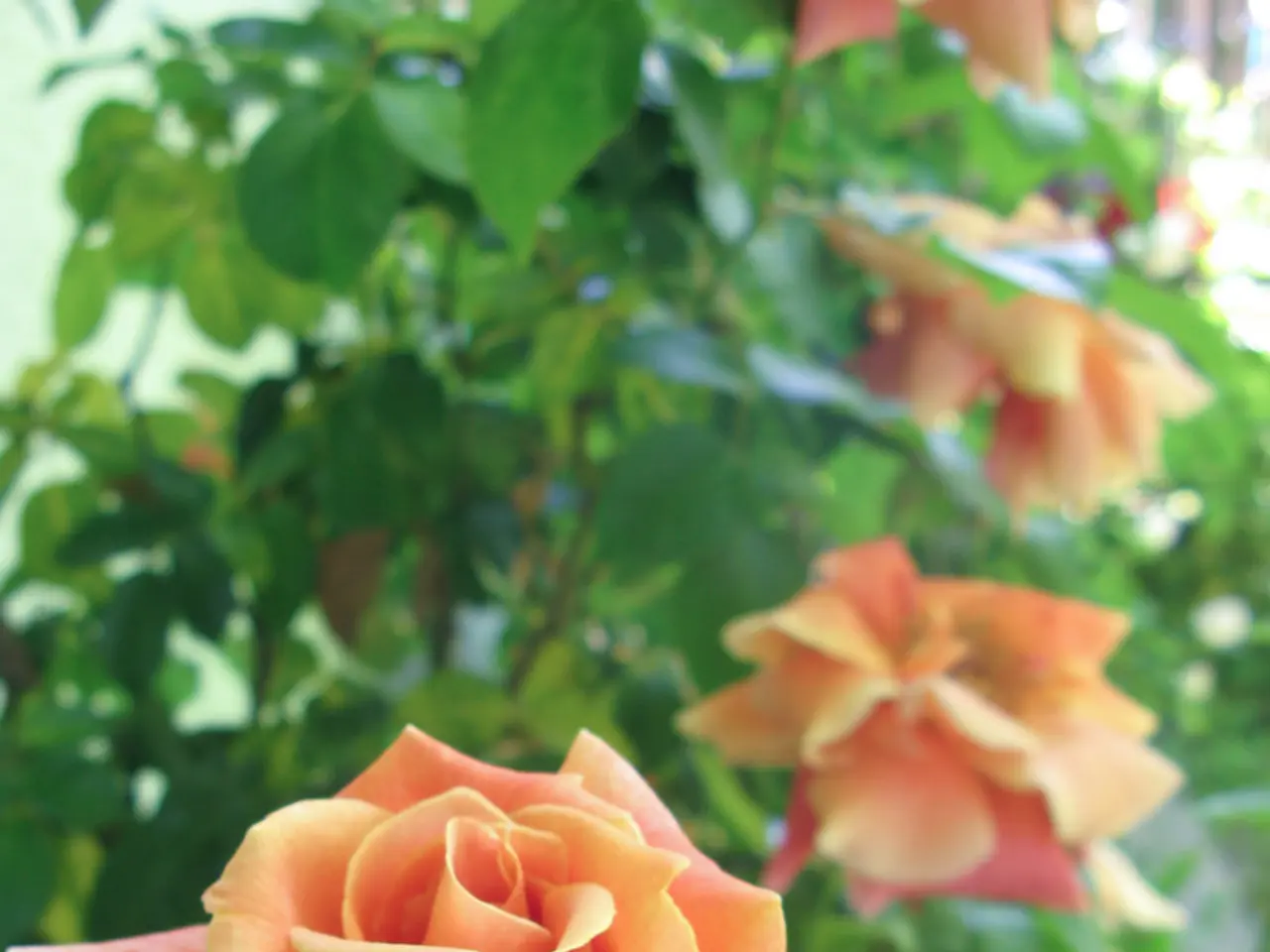"Easily Multiply Your Rose Plants with This Simple Technique for Guaranteed Success"
In the heart of gardening season, propagating roses from semi-ripe cuttings is a cost-effective and rewarding endeavour. Here's a simple, step-by-step guide to help you grow your own roses.
Step 1: Choose the Cutting Select a healthy, non-flowering stem from the current season's growth that has started to harden but is not fully woody (semi-ripe). The cutting should be about 20 cm (8 inches) long, cutting just below a leaf node.
Step 2: Prepare the Cutting Remove the lower leaves to reduce moisture loss and expose the leaf nodes, which can develop roots. Optional: score (scratch) the lower stem to expose the cambium layer, encouraging root growth.
Step 3: Rooting Hormone Dip the cut end in rooting hormone powder or gel to stimulate root development and improve success rates.
Step 4: Planting Medium Insert the cutting into a well-draining propagation medium such as a mix of compost and sharp sand or perlite. Ensure the soil is moist but not waterlogged.
Step 5: Create a Humid Environment Cover the pot with a plastic bag or place in a propagation station to maintain humidity. Keep the cutting in a warm area but out of direct sunlight to prevent drying out.
Step 6: Care and Maintenance - Mist regularly to keep humidity high. - Protect cuttings from wind, heavy rain, and harsh conditions. - Be patient; some cuttings may root quickly, while others take weeks. - Label your cuttings to keep track of varieties or dates.
Step 7: Transplanting Once roots have formed (usually in several weeks), gradually acclimate the new plants to outdoor conditions before planting them in their permanent location.
Taking several good-quality cuttings from each plant increases the chances of success in growing roses from cuttings. This process combines proven horticultural practices for semi-ripe cuttings and specific advice tailored for roses to maximize propagation success.
Semi-ripe cuttings taken in late summer and early fall are easier to propagate compared to softwood cuttings taken early in the growing season. All you need to do to look after your cuttings is to ensure the soil doesn't dry out, then wait for spring.
When propagating roses, it's essential to use sharp, sterilized hand pruners for cutting the stems. Cuttings should be at least 8-10 inches (20-25cm) long, young from the current year, and free of damage or disease.
Wear thick gloves to prevent injury and pull off all the leaves from the lower two-thirds of the stem, leaving only the top set. Each cutting should be trimmed at the top and bottom, with a 45° angle cut at the top to aid water runoff and a flat cut at the bottom.
Fill the pot with well-draining compost mixed with perlite or vermiculite. Choose a protected spot that receives some shade from the midday sun. Propagating roses from cuttings is a cost-effective way to expand a plant collection and start a rose garden.
Cuttings should be taken early in the morning while the stem is still moist. If cuttings are not potting up immediately, they should be sealed in a Ziploc bag to retain freshness and moisture.
Once the cuttings have become well-established in their new containers, they are ready to be planted into their permanent position in the garden. In around April, examine your cuttings. If they have been successful, they should have developed shoots at the top, and you may see roots coming out of the holes in the bottom of the pot.
When propagating roses, it's a good practice to remove any thorns by applying pressure to the sides. Hardwood cuttings taken later in the fall are even more robust and can be propagated in the same way as semi-ripe cuttings.
[1] RHS Propagating Roses: https://www.rhs.org.uk/advice/profile?pid=365 [4] The Old Rose Society: https://www.oldrosesociety.org/propagation-of-roses/
By following this detailed guide, you can propagate roses from semi-ripe cuttings, a cost-effective method suitable for home-and-garden enthusiasts and gardening hobbyists looking to expand their home rose garden or start a new one. In the summer and early fall, taking cuttings during the heart of the gardening season will increase your chances of success in growing roses from cuttings.








